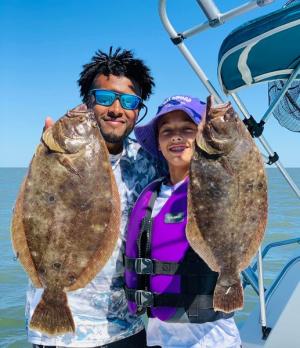Fishing in Delaware Bay is beginning to look like it did many years ago when my grandfather and his friends from American Viscose in Marcus Hook, Pa., used to fish with Captain Green out of Slaughter Beach. They all worked shift work, and they would go down at the end of their night shift and spend the day on the water.
At first, in the late 1940s, the primary target was porgies, then it was croakers. That was in the 1950s, when I was old enough to go. By then, Pop had been retired from the Viscose and we had a 35-HP Elgin outboard that we put on a wooden boat rented from a lady in Slaughter Beach. It was a short run to the Coral Beds and we usually caught lots of croaker, and on one very good day we each caught a big trout.
That seems to be what we are seeing now. The reef sites are holding plenty of panfish, from croaker and spot to trout and flounder. There are even triggerfish and sheepshead, fish that I had never heard of back in the ‘40s and ‘50s.
In addition to the reef sites, the fishing pier at Cape Henlopen Sate Park has been producing lots of spot. I had a report from Tuesday, when all the boats were tied to the dock because of the strong east wind, that said spot were caught from the pier as fast as you could get a Fishbites bloodworm to the bottom.
Broadkill Beach has also seen good fishing for spot, croaker and kings. This is a less-crowded location than the ocean beaches and can be fished with lighter tackle.
Sheepshead have certainly been big news from Delaware Bay this year. Many fish over 8 pounds have been caught on sand fleas worked around rock structure such as the Outer Wall, the Ice Breakers and the bases of the lighthouses.
I have had reports of small blues chasing bait on the surface in different locations up and down the bay. These can be fun on light or even fly tackle. Please use barbless hooks to make catch-and-release easier.
This year’s slot rockfish season was much better than 2021. Keepers were caught from the tidal creeks and rivers on peeler crab, swimbaits and eels.
Not to get anyone’s hopes up, but there have been more keeper trout caught this year then any since I can’t remember when. Will this be the start of a comeback? I have no idea. I can tell you this is how it began in the late 1960s.
I remember Bobby Woods and I were sitting in his wood lapstrake Grady-White boat catching one small trout after another just outside Indian River Inlet. That was in the late ‘60s or early ‘70s and we had no idea what was to come.
A few more fish for us
When the National Oceanic and Atmospheric Administration first came out with its allocation of fish between the commercial and recreational fisheries, many of us in the recreational fishing business were outraged. The allocation of summer flounder was particularly outrageous. Commercial fishermen were awarded 60% of the available catch while recreational fishermen got only 40%.
That was back in the 1980s, and it has been a thorn in our side since then. Finally, NOAA has taken a look at the catch reports from the Marine Recreational Information Program and the commercial fishermen’s landings, and decided that recreational fishermen do land more flounder, scup and black sea bass than commercial fishermen. Those who are familiar with my opinions know I have very little faith in the MIRP findings, but of course, NOAA and its bean counters believe it as gospel. This is one time when they worked in favor of recreational fishermen. Always remember, NOAA is a part of the Commerce Department.
In the end, we didn’t exactly break the bank, but we did get a few more fish. The new allocation gives recreational fishermen 45% of the summer flounder allocation, dropping the commercial down to 55%. Scup (porgies) saw a pretty big jump, up from 22% to 35%. The commercial allocation fell from 78% to 65%. Black sea bass saw the smallest change. The recreational allocation moved from 51% to 55% while the commercial dropped from 49% to 45%.
Exactly what this will mean as far as the number of fish we will be able to take home remains to be seen. Remember, this is only a percent of the allocation. The allocation is determined by many factors including the size of the spawning stock biomass, the spawning success of the past few years, the over or under catches made in the past and the always-popular MIRP.
























































